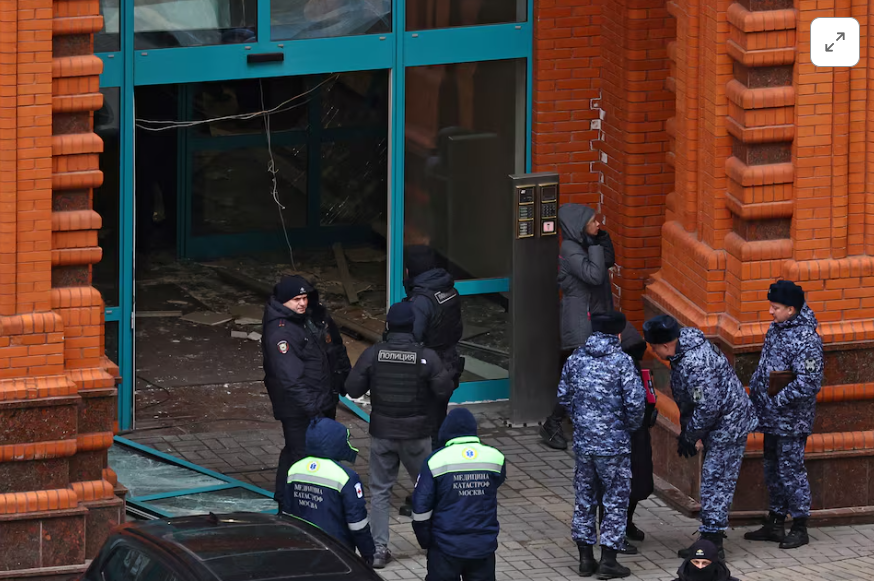Peter Sellars isn’t afraid of taking risks. It’s part of his approach to making work, as his 2024 production of Beatrice di Tenda showed. For this new staging of Jean-Philippe Rameau’s Castor et Pollux for the Opéra National de Paris at the Palais Garnier, he opts not for the better known 1854 version of Rameau’s piece but for the 1737 version with its prologue that was subsequently axed from the later version. Restoring the 1737 version gives the opera a very different opening. Here, in the aftermath of conflict, a city sits in ruins. Mars, the god of war—here portrayed by Nicholas Newton as a stern military general —has the arts in chains. The arts plead with Venus (Natalia Smirnova) clad in black replete with veil, to return to Earth and chain up Mars so this imprisonment will end. She co-opts their son Amor (a beautifully expressive performance from British tenor Laurence Kilsby) to shoot him with an arrow of love which has Mars temporarily surrender. Peace, however, is short for Mars’ entourage shoot down Amor in retaliation. Love lies wounded – youth and the future in peril — as Act 1 commences.
The decision to present the prologue effectively frames Castor et Pollux as a tale centred on Pollux’s emotional journey: the guilt experienced when his brother is killed by his rival Lynceus, the turmoil generated by his obsession with his brother’s loyal fiancé Télaire (the luminous Jeanine De Bique) and a drive for revenge. Sellars’ reading is centred on positioning Pollux’s journey as a wider reflection on what it means to learn to live with the dead, take responsibility for your actions and promote an ethos of generosity and humility that should be manifest in all we say and do.
Joelle Aoun’s mundane set is, on one level, intentionally nonchalant and unremarkable. Stage left a basic kitchen table and chairs look like they were bought from IKEA some years back. Non-descriptive kitchen cabinets and a fridge linger behind. Centre stage a pink-red sofa that has seen better days with a rectangular boxy table immediately in front. Stage right a bed and behind a basic shower replete with a flimsy white shower curtain. There is nothing distinctive about what we see. Nothing remarkable. What is remarkable, however, is how the space is steadily animated by the narrative which blends the different worlds – the living and the dead, the earth and the skies, times of peace and times of war — that the opera navigates.
At the back of the stage, imposing video projections by Alex MacInnes provide the sense of a domestic world which needs to be contextualised within a broader cosmic universe. A bombed tower block, a refinery and telegraph poles are soon replaced by stunning cloudscapes and a universe in motion – stars, planets twinkling in a shifting canvas. Flashes of lights in the urban landscapes remind the audience that this is a universe in motion – are they bombs, lamps, fireworks? We never find out. There is a mystery to the landscape — recalling that provided by Bill Viola for Sellars’ Tristan and Isolde (2005) that dwarfs the action. A sense that there is always a wider planetary context that societies ignore at their peril. The visual juxtaposition of the intimate, domestic setting against an elemental sky and cloudscape is a reminder that one frames and gives meaning to the other. The costumes are contemporary but unspectacular; this is a world where the spectacular comes in the ways in which the characters learn to live with the dead, to put aside their privilege (in the case of Pollux, immortality) to support each other.
At the heart of Sellars’ production is an understanding of the human cost of conflict. Jeanine De Bique’s Télaire excels as Castor’s grieving fiancé. She mourns his death (“Tristes apprêts, pâles flambeaux”) with a lovely smooth vocal line that is both expressive and still. As Marc Mauillon’s Pollux struts and paces, driven by a desire for vengeance and a lust he hesitates to name for his dead brother’s fiancé. Télaire mourns and waits as grief and faith intersect to powerful effect in her outstanding performance.
Sellars’ reading positions this as a piece both about destiny and fraternal love and also about the wider social rifts exposed by the senseless murder of Castor. So much of the energy of the piece comes from the chorus of singers and the ensemble of dancers that give physical form to Rameau’s music. The violent choreography enacted by Cal Hunt’s flex dancers is intricate, elaborate and expressive. The choreography in many ways mirrors the aggression of the score, as in the beating of Amor in the opening prologue. The relentlessly energetic score finds a complement in the jagged, physical choreography that Hunt provides – bodies contorting across different shapes and configurations. The protagonists need to find their way around the bodies that serve as obstacles in their path. At times the dancers give form to the characters’ emotions, at other moments, they cut through the music providing a counterpoint or commentary on the action.
Sellars’ physical choreography demonstrates a deft attention to detail. The hand gestures as Télaire tries to persuade Pollux to plead with his father Jupiter for Castor’s return in Act 1 are fluid and delicate. Baritenor, Marc Mauillon, deploys his grainy voice to gruff effectiveness as the tormented Pollux, torn between desire and duty. In his camouflage fatigues, he cuts an increasingly drawn figure.
One of the challenges in staging this piece is how to align the long dance sequences in such a way that sustains and amplifies the emotional drama; Sellars does this through the deployment of the Chorus in Act 1, empowering Pollux to rescue his brother. Surrounding him behind the red sofa they act as his conscience, reminding him of the need to think beyond himself.
The integration of the Chorus, dancers and characters is particularly effective in Act 3 as Pollux enters the gates of Hell with Stéphanie d’Oustrac’s impulsive Phébé trying to stop him, realising that he loves not her but Télaire. Télaire seeks to keep Pollux focused on the task of freeing Castor, while the dancers give shape to the perils of the journey. Here, they are the demons and monsters that guard the gates to the underworld. In Act 4 their luminous costumes lend an ethereal aura to the underworld.

Cal Hunt’s choreography gives form to the underworld in Castor et Pollux. Photo: Vincent Pontet – Opéra National de Paris
The first image of Castor caressing a sleeping Télaire alongside a flautist/recorder player giving musical shape to his emotions provides a welcome moment of intimacy following the frenzy of the underworld as the dancers fall out of the fridge and cupboard, tumble out of the sofa — at one point trying to drag Phébé into the underworld — and tussle with the shower curtain. The coffee table doubles as Castor’s coffin; he emerges from it bringing his otherworldliness to the domestic space. The dancers’ physicalisation of Pollux’s dream, provides an in-yer-face insight into his restless and disturbed state of mind.
Castor et Pollux is not an easy piece to pull off. It is long with extended dance passages that seem to dissipate the dramatic tension, but Sellars uses the choreography to provide a through line to help bind the piece as a dramatic whole. The staging is ambitious, it pushes and pulls at the score with a relentless pace punctuated by De Bique’s gravitas and emotional grounding. Her hands draw patterns across the air, articulating her grief and longing. Her pure vocal tone and the pianissimo that Currentzis’ conducting prioritises provides a smooth intensity that contrasts with the spiky choreography of the dance ensemble. As Castor, Van Mechelen sings with an appealing bright tone showing elegant vocal agility and musicianship. The duets with his fiancée are realised with a quiet stillness provides a welcome tonal shift.
Currentzis draws out each note of the score, relishing its lush beauty and conjuring some exquisite playing from the Utopia Orchestra. At the end as the cast, chorus and dancers come together to celebrate the triumph of love over adversity, food and wine are brought on stage as “Fête de l’Univers” closes the opera. The opening prologue advocated for the end of war. Perhaps the end is an indication that war has, if not ended, paused as the twin brothers celebrate togetherness with the chorus and dancers. Yes, not everything quite fits together logically when the action is read against Sellars intricate programme notes: it’s not clear if Castor was killed at home or on the battlefield, or what Jupiter’s role as father to Pollux but not Castor is in the final reconciliation, or how Phébé survives her decent into the underworld. Sellars’ staging, however, invites the audience to take a less literal view of both the piece and the staging. The result is a courageous production unafraid of asking questions of the legacy of Rameau’s piece and advocating for a version that has been too often relegated to second best.


Togetherness: the finale of Castor et Pollux. Photo: Vincent Pontet – Opéra National de Paris
Castor et Pollux plays at the Opéra National de Paris (Palais Garnier) from 20 January to 23 February. A recorded version is also available on the Paris Opera Play.
This post was written by the author in their personal capacity.The opinions expressed in this article are the author’s own and do not reflect the view of The Theatre Times, their staff or collaborators.
This post was written by Maria Delgado.
The views expressed here belong to the author and do not necessarily reflect our views and opinions.













![V4 Improv Connect: Empowering Cross-Border Collaboration And Growth (Project And Network) [Part I]](https://thetheatretimes.com/wp-content/uploads/2025/01/1-Photo-credit-Vesna-A-Briskoska.jpg)


